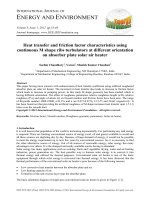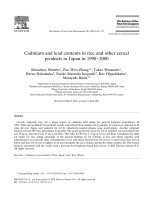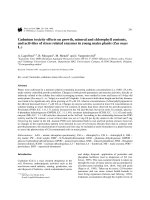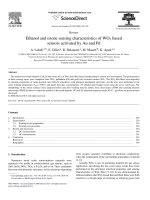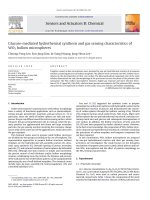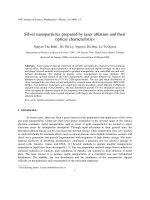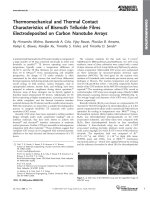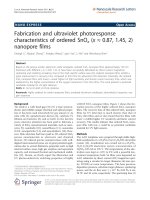Dioxins and Furans Contents Characteristics
Bạn đang xem bản rút gọn của tài liệu. Xem và tải ngay bản đầy đủ của tài liệu tại đây (109.02 KB, 9 trang )
Dioxins and Furans
Contents
Characteristics
Lesson Material
Practice Problems
Formation Mechanisms
Lesson Material
Practice Problems
Control Techniques
Lesson Material
Practice Problems
1
Dioxins and Furans
Characteristics
Contents
Lesson Material
Practice Problems
Objective
1. Describe the basic characteristics of dioxin and furan compounds.
Lesson Material
Sources of dioxins and furans include waste incinerators, cement production, fossil-fuel-fired combustors,
and forest fires.
Dioxins and furans are compounds with the general chemical structure shown in Figure 1 . There are a
large number of individual dioxin and furan compounds called congeners. There can be as few as one or
as many as eight chlorine atoms substituted on the dioxin or furan ring compound.
The dioxin and furan compounds having from four to eight chlorine atoms are considered especially toxic.
All of the dioxin and furan compounds are considered potentially toxic.
Dioxin and furan compound emissions are calculated and regulated in two different ways:
1. As the total dioxin and furan compound concentrations
2. As the Toxic Equivalency Quotient (TEQ) concentration
The TEQ value for dioxin and furan emission is calculated according to a toxicity weighting scale. The
compound 2,3,7,8 tetrachlorinated dibenzo-p-dioxin is usually considered the most toxic compound and is
assigned a weighting factor of 1.0. Sixteen other dioxin-furan compounds are assigned weighting factors
ranging from 0.5 down to 0.001. The observed concentrations of these seventeen dioxin-furan congeners
are multiplied by these weighting factors to determine the total concentration of dioxin-furan compounds
2
that have a toxic equivalent to 2,3,7,8 tetrachlorinated dibenzo-p-dioxin. This concentration is usually
expressed as dioxin-furan compounds in TEQ nanograms per cubic meter.
The TEQ value is often used in regulatory limits because it is most closely related to the adverse health
effects believed to be associated with dioxin and furan compounds.
Procedures for calculating the TEQ values are discussed in the lesson on Concentration in Module 2.
3
Dioxins and Furans
Formation Mechanisms
Contents
Lesson Material
Practice Problems
Objective
1. Describe the basic formation mechanism for dioxin and furan compounds.
Lesson Material
The formation mechanisms for dioxin-furan compounds have not been fully identified. It is believed that
there are at least three different types of formation mechanisms that are possible. All of these depend on
the availability of chlorinated precursor compounds in the fuel and/or waste being burned and the
appropriate gas temperature conditions. One of the proposed formation mechanisms for dioxin-furan
compounds involves reactions on the surfaces of particles entrained in the gas stream.
Dioxin-furan concentrations appear to increase over the temperature range from 400 to 1,000°F.
However, at temperatures well above 1,000°F, dioxin-furan compounds are readily oxidized.
As Figure 1 illustrates, some dioxins and furans form and are destroyed (i.e. oxidized) in the burner
flames of combustion chambers. Most of the chlorinated precursor compounds, which originated in the
fuel and/or waste, volatilize and move with the gas stream through the combustion process until they
reach the temperature range favorable for dioxin and furan formation (400 to 1,000°F). A small
percentage of dioxins and furans can form in boilers where the economizers and heat exchange
equipment are located. Since most dioxins and furans tend to form in control devices, gas streams
leaving combustion processes should be cooled to temperatures below 400°F.
4
5
Dioxins and Furans
Control Techniques
Contents
Lesson Material
Practice Problems
Objective
1. Explain how concentrations of dioxin and furan compounds can be reduced.
Lesson Material
Combustion studies indicate that both dioxin and furan compounds are destroyed when the gas
temperatures exceeds approximately 1400°F. In fact, oxidation of these compounds is completed at lower
temperatures than some other forms of partially oxidized compounds as indicated in Figure 1. These
temperatures usually exist in the combustion zones of incinerators and fossil-fuel-fired boilers.
The formation mechanisms decrease to negligible rates when the gas stream temperature decreases
below 400°F. Accordingly, ensuring that the gas stream is sufficiently cooled prior to the air pollution
control system can eliminate this formation mechanism. Cooling is accomplished in the heat recovery
equipment (economizers and air preheaters) or in the incinerator waste heat boilers.
The best way to control dioxin and furan emissions is preventing their formation by reducing or eliminating
the chlorine in the fuel and waste material being burned.
6
Dioxins and Furans
Practice Problems
Characteristics
#1
All dioxin and furan compounds contain the element:
a.
b.
c.
d.
Fluorine
Bromine
Iodine
Chlorine
Answer: d. Chlorine
All dioxin and furan compounds contain the element chlorine. There can be as few as one or as
many as eight chlorine atoms substituted on the dioxin or furan ring compound.
#2
True or False? Only specific dioxin and furan compounds are considered to be toxic.
a. True
b. False
Answer: b. False
All dioxin and furan compounds are considered to be potentially toxic. Dioxin and furan
compounds having from four to eight chlorine atoms are considered to be especially toxic.
#3
What are the two methods in which dioxin and furan compounds are calculated and
regulated?
Answer: Dioxin and furan compounds are calculated and regulated in the following two ways:
1. As total dioxin and furan compound concentrations
2. As Toxic Equivalency Quotient (TEQ) concentration
#4
Why is 2,3,7,8 tetrachlorinated dibenzo-p-dioxin used as the basis for the TEQ
calculations?
7
Answer: This congener is considered to be the most toxic of all of the dioxin and furan
compounds.
Practice Problems
Formation Mechanisms
#1
Dioxin and furan compound formation generally ____________ over the gas temperature
range of 400 to 1000°F?
a. Increases
b. Decreases
c. Remains unchanged
Answer: a. Increases
Dioxin and furan compound formation usually increases over the gas temperature range of 400 to
1000°F.
#2
The formation mechanisms for dioxin and furan compounds depend on:
a.
b.
c.
d.
e.
Appropriate gas temperatures
Humidity levels of 95% or greater
Availability of chlorinated precursor compounds
a and c, only
a, b, and c
Answer: d. a and c, only
The formation mechanisms for dioxin and furan compounds depend on appropriate gas
temperatures and the availability of chlorinated precursor compounds.
Practice Problems
Control Techniques
#1
8
Which minimum temperature is usually needed to destroy dioxin and furan compounds in
waste incinerators?
a.
b.
c.
d.
e.
2000°F
1400°F
1000°F
500°F
528°R
Answer: b. 1400°F
A temperature of 1400°F is usually needed to destroy dioxin and furan compounds in combustion
processes.
#2
How can the formation of dioxin and furan compounds be suppressed?
Answer: The formation mechanisms for dioxins and furans decrease to negligible rates when gas
stream temperatures are held below approximately 400°F. Heat recovery equipment
(economizers and air preheaters) and incinerator waste heat boilers are used to cool gas streams
below this temperature before they reach the air pollution control system.
9
